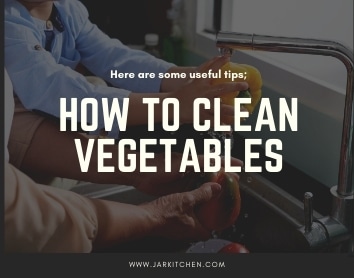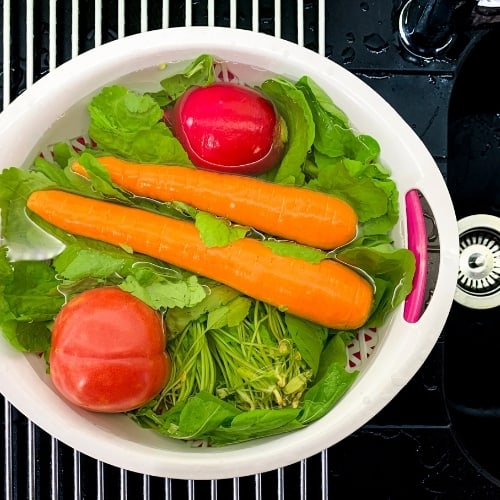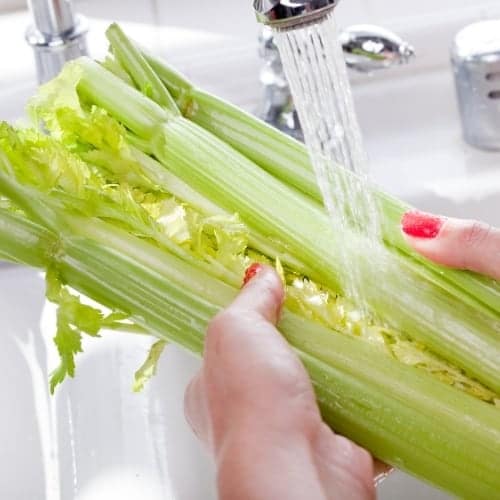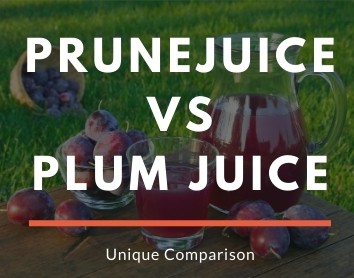Table of Contents
Even vegetables and fruits are not innocent anymore, let’s face it. Even the most “natural” one is exposed to a variety of chemicals. Let’s just say it didn’t happen, there are lots of bacteria, parasites on it. As such, it is of great importance to clean them thoroughly and wash them well. When you say “how to clean fruits and vegetables for juicing”, you may see this process as very simple. But let’s be clear, unfortunately, there are very few people actually applying the methods we’ll describe in a moment.
In short, you cannot get rid of dirt, parasites or chemicals by taking the vegetables. And fruits you will use and keeping them under water for two minutes. You should pay more attention to each of them, even if a little time.
Because there is nothing worthy of health in this world. Spare 5 minutes to reading this article, it is going to be worth it.
In order to eliminate the harmful effects of bacteria, viruses, and insects in vegetables and fruits. The substances called pesticides are used and these substances endanger health.
Pesticides threaten health
How to clean fruits and vegetables for juicing we buy from markets, grocery stores. And also markets are rich in fiber, vitamin, and mineral storage. Consumption of 3-5 servings of fruits and vegetables during the day is also important for adequate and balanced nutrition.
On the other hand, taking pesticides into the human body through food can cause adverse effects. They on the respiratory, circulatory and cardiovascular system, liver, kidney, and digestive systems. For this reason, removing pesticide residues from fresh fruits and vegetables is of great importance for our health.
Fruits and vegetables should be washed carefully.
In today’s conditions, it may not always be possible to find or buy organic fruits and vegetables. To remove pesticide residues from food, the first thing usually people do at home is to put these foods in water with vinegar. However, water with vinegar is not effective in reducing pesticide residues, but in reducing the microorganism load. Studies have shown that vinegar water increases the effectiveness of pesticide residues even more. The main purpose of adding vinegar to the washing water is to create an acidic washing environment. And to remove potentially harmful biological factors that can be found on the food in case of insufficient washing. However, many of the pesticides are widely used today. It cannot be removed from food and taken into the body due to insufficient washing. This causes pesticides to maintain their harmful effects for long periods of time.
10 grams of baking soda in 1 liter of water
Water with vinegar should not be used to remove drug residues on vegetables and fruits. Soaking in lukewarm water and putting 10 grams of British carbonate in 1 liter of water. And washing vegetables and fruits in this solution for a minimum of 8 minutes. Then rinsing will be the most effective method to remove pesticide residues. If desired, vegetables and fruits can also be purified from bacteria. It by washing them in water with vinegar after carbonated water.
Best known: Soak in vinegar water
We have seen from our mothers and grandmothers; soaking in vinegar water is one of the most frequently used methods.
You add 1 cup of vinegar to approximately 3 cups of room temperature water, add vegetables and fruits to this mixture and let it sit for a maximum of 20-25 minutes. Of course, you do not neglect to increase or decrease the amount of water and vinegar mixture according to the number of vegetables and fruits you will wash. Then, if you rinse well with clean water, it’s okay.
So, what does this method do? How to clean fruits and vegetables for juicing with vinegar? Vinegar water works as a natural antiseptic thanks to the antibacterial properties of vinegar. In other words, as we mentioned at the beginning, it is your biggest supporter against many microbes, bacteria, and parasites that live on vegetables, and it cleans them from the vegetables and fruits you will eat.
But let’s see that when it comes to pesticides and all kinds of chemicals used, keeping them in water with vinegar is not a solution by itself. After waiting, you need to gently rub your vegetables and fruits under running water and wash them for a long time.
How to use vinegar water
With the addition of lemon: Add some lemon juice into the vinegar water mixture. If you want to squeeze citrus fruits, check out our best orange juicer reviews!
If you want to clean your vegetables and fruits with a different and effective method without waiting for a long time in the vinegar-water mixture, add freshly squeezed lemon juice to the vinegar and water duo.
Prepare the mixture, 1 part each, and place it in a clean spray bottle. Then, spray the mixture with the help of a spray to touch all the vegetable or fruit you want to clean and let it sit for 10 minutes.
After 10 minutes, rinse thoroughly with clean water and consume it with pleasure.
Must clean separately: Do not try to wash all the vegetables and fruits you will use at the same time.
If you are going to know how to clean fruits and vegetables for juicing or to cook a meal or to eat in a large group, you should not try to wash them all in the same bowl. Yes, maybe this will save you space and time, but you can never be sure it will not have more negative consequences in the long run.
First of all, vegetables and fruits are washed in the same way. It is wrong to put them in water with vinegar. If we put this aside and if you bring together all the vegetables and fruits that have been grown in different fields. It is used on different pesticides and under the influence of other parasites or bacteria. It is possible that they will be affected by each other. And infect other vegetables and fruits with all their negativity.
In short, be you, wash your vegetables and fruits separately according to their types.
If you are looking for things to do with apple cider vinegar, check out the website of Dr. Oz!
How to clean peel fruits or vegetables
Peels are important: Use a brush when washing vegetables and fruits with thick skins.
One of the most important issues you should pay attention to while washing vegetables and fruits is their peels. If you are going to wash vegetables and fruits that you usually peel off, such as melons, watermelons, oranges, tangerines, and bananas, you need to be more careful than ever before.
Because thinking “I don’t eat the shell anyway, I throw it away” is actually a big mistake. Without washing or washing it cursory, you make it easier for the dirt, bacteria, chemicals in the peel to pass into the fruit part of the food and enter your body.
Instead, it would be best to answer how to clean fruits and vegetables for juicing, these thick-skinned vegetables and fruits by rubbing them under running clear water with a brush. You can then cut it off with a clean knife again, or quickly remove the shell so that the outside of the shell has minimal contact with the fruit.
If you consume without peeling: Thin-skinned vegetables and fruits should dry well after washing
You should be more careful than you think while washing vegetables and fruits. This thin-skinned or unshelled; such as peppers, tomatoes and apples.
You can use the vinegar water method to wash these foods, after soaking in vinegar water, under running clear water, this time using a soft brush, and finally dry with a clean cloth.
Thus, the last harmful substances that do not go away with water will disappear completely thanks to the clean cloth, and you will enjoy your vegetables and fruits.
As you know, all leafy vegetables such as lettuce, lettuce, cabbage and parsley, which we call green in general, grow very close to the soil, so there is a high probability of microorganisms or even insects on them.
How to wash kale for juicing?
It is not possible to hold the cabbage in water and clean it in real terms.
So how do we wash cabbage for juice? First of all, we divide them into beautiful layers, branches or leaves. Then we put the water with vinegar into the circuit again.
After keeping it in vinegar water for a while and removing the harmful substances on it, we clean it for the last time with clear water and consume it with pleasure without waiting too long.
How to clean celery for juicing?
Cut out the stalks closest to the body of the celery.
Cutaway any yellowed or rotten leaves.
Wash the celery stalks thoroughly in clean water.
Fill a large bowl with water and leave the celery in it for 10 minutes.
It is essential to be sensitive: Do not contact with water for more than 1 minute while cleaning forest fruits.
Forest fruits are among the most delicate. In fact, they are very vulnerable with their soft and crusted structure.
For this reason, it is necessary to be sensitive while knowing how to clean fruits and vegetables for juicing and washing them. While brushing or rubbing is an option that will never even be thought of, soaking in water with vinegar is one of the methods that should not be preferred because it will damage both taste and texture.
To wash the forest fruits, gently take them out of their packaging and put them in a strainer, and rinse them thoroughly in room temperature or cold water. Remember, it is important that the water is running water and that you do not keep it underwater for longer than 1 minute. Mind you alone, flowing water should flow calmly, not with pressure.
It can be difficult to keep for long periods after washing because berries are very prone to watering. Therefore, after you decide to eat forest fruits for sure or use them in a recipe, you should wash them.
Conclusion for how to clean fruits and vegetables for juicing
Best alternative: Meet with tea tree oil and use it with peace of mind while cleaning your vegetables and fruits.
Tea tree oil can use in completely different areas ranging from many skin ailments to cleaning vegetables and fruits. Thanks to its antibacterial properties. If you ask how to use tea tree oil, which you can easily obtain from the herbalists you trust, to clean vegetables and fruits, let’s explain immediately: You drop 6-7 drops of tea tree oil into a large bowl filled with water and drop the food you want to clean into this mixture. You just wait for a few minutes and then rinse your vegetables or fruits. That’s it.

This is Berk from the JarKitchen Team. I am a Mechatronics Engineer and I like cooking in my spare time. By bringing my engineering background into the business, product reviews are a specialty for me. During my travels across Europe, I have learned/tested many recipes and now I plan to bring them to you here!









